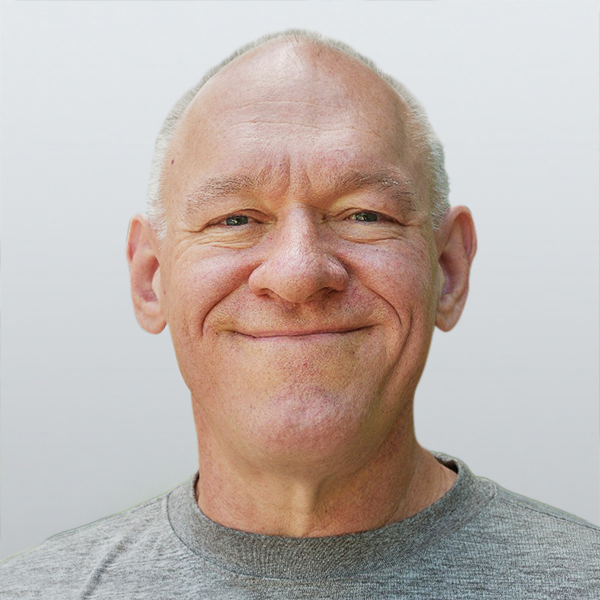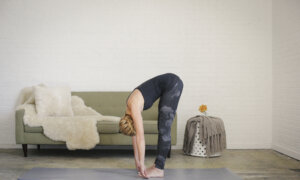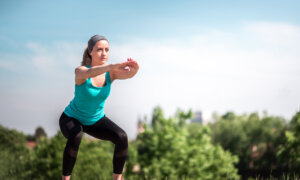One of the more pronounced postural challenges we see in the clinic is kyphosis, a forward curvature of the spine. Originating from the Greek word kyphos, it means “hump” or “crooked.” There are many different causes for kyphosis, including postural habits and muscular weakness.
Hyperkyphosis is the advanced form of kyphosis that often occurs with age. It can develop from muscle weakness or degenerative disc disease. This condition can affect a person’s ability to move around, and it raises the risk of experiencing falls and fractures.
Kyphosis rarely occurs alone. One of the first things I check when someone has advanced kyphosis is their overhead reach.
Shoulder flexion that typically results in overhead reach can instead lead to a straight-out reach because of the changing angle of the shoulders. Accessing things such as overhead kitchen cabinets can be difficult, and the increased workload can cause shoulder pain. Kyphosis can hinder the support the spinal cord provides against gravity. The bent spine loses its ability to bear weight and shifts the body mass forward, placing extra pressure on the lower spine and causing discomfort and pain.
Improving your posture can have a positive chain reaction. When you stand upright, your body becomes a strong and well-supported structure. Even if a patient is weak, good posture can help them better maintain function. Conversely, a kyphotic posture places vastly increased demands on already weak muscles and can reduce function beyond the simple weakness.
The following exercises can help you avoid progressing in kyphosis due to muscle weakness or postural fatigue. Being mindful of your posture can have long-term benefits, helping you remain functional and pain-free.
These exercises are generally safe and well-liked by my patients. However, consult your doctor to confirm that they’re suitable for you.
6 Easy Exercises to Reverse Kyphosis
1. Walking
Walking is truly a universal balm for health, which is why I like to include it in almost every regimen. The trick for incorporating it into a postural regimen is that you absolutely need to practice your best posture while walking.
This can be challenging if you’ve already developed a hunched posture, but don’t give up. Keep practicing, and you’ll eventually get there.Step 1: Start walking at a slow pace, allowing your body to warm up. Maintaining an upright posture, as well as keeping your shoulders up and back, head up and back, and shoulders squared, is important.
Step 2: Once warmed up, accelerate to your normal walking speed and continue for approximately 30 minutes while keeping a close eye on your posture.
Step 3: Allow 5 minutes to cool down.
Walking while keeping your posture upright can be surprisingly exhausting, so do what you can at first and work up from there.
2. Pectoral Stretch
I perform this exercise regularly and love it. Your pectoral muscles can cause your shoulders to pull forward, which can lead to problems such as upper crossed syndrome or kyphosis. This exercise is posturally delightful when performed in the morning. It’s an easy exercise to do anywhere because all you need is a doorway.

(Chung I Ho/The Epoch Times)
Step 1: Stand in front of an open doorway while placing your hands on the door frame at shoulder level. (A closed door would make this exercise ineffective but could provide comedic relief.)
Step 2: While keeping your hands in place, slowly lean through the doorway, gently pushing into a stretch until you reach a comfortable limit. If the doorway is wide, you can straighten your elbows enough to reach the frame.
Step 3: Lean through the doorway until you feel an intense stretch. Don’t push into pain, but do make sure you push as far as you comfortably can. Hold the position for approximately 30 seconds before resting.
Step 4: Each 30-second hold counts as 1 repetition. Try to complete 3 total repetitions.
You can step forward with one foot while stretching to intensify the movement. This often becomes easier as your muscles and joints relax.
3. Cervical Retractions/Chin Tucks
We’ve all known people who like to stick their noses into someone else’s business. It also isn’t advisable to stick your nose too far out in front of your body. A forward head posture can eventually lead to moving your shoulders forward, which can cause rounding and lead to kyphosis. On the other hand, maintaining a tall and proud posture with your head can help maintain and strengthen your shoulder position.

(The Epoch Times)
Step 1: Stand or sit with your trunk upright and your shoulders back.
Step 2: Place the fingers of one hand on your chin. While keeping your head up and nose pointing straight ahead, apply gentle pressure with your fingers, pushing your head straight backward while pushing your chin down. Be sure to engage your neck muscles.
Step 3: Once your head is back as far as it is comfortable without pain, hold this posture for 30 seconds.
Step 4: This counts as 1 set. Try to perform 3 sets.
Be sure to maintain a tall, upright posture the entire time and avoid slumping.
4. Wall Angels
Although my computer’s spell-checker kept questioning if I meant “wall angles” instead of “wall angels,” you won’t have to question if these exercises are effective because you’ll feel it immediately. There’s nothing like a flat wall to help you work on a curved posture.

(Chung I Ho/The Epoch Times)
Step 1: Press your entire back as flat as you can against a wall. Your feet should be about shoulder-width apart and roughly a foot’s width from the wall.
Step 2: Bring your elbows out to your sides and level with your shoulders while pressing the back of your hands and elbows against the wall. Your arms should look like a football goalpost.
Step 3: While pressing into the wall with your back, slowly reach your arms over your head until your shoulders and elbows are fully extended. Hold for about 30 seconds, then slowly return to the starting position.
Step 4: Each 30-second hold counts as 1 set. Try to perform 3 sets.
Avoid arching your back, and always try to maintain contact with the wall. You may hear some pops and cracks from your spine, but that’s not a bad thing.
5. External Rotation and Scapular Retraction
This is a great exercise to perform after wall angels. It also works on improving your posture by targeting your upper spine and shoulders.

(Chung I Ho/The Epoch Times)
Step 1: Sit or stand as tall as you can with your shoulders down, arms by your sides, elbows bent 90 degrees, and hands out in front of you.
Step 2: Extend your hands as far apart as possible while keeping your elbows at your sides. Tightly squeeze your scapulae together and hold for 30 seconds, then release.
Step 3: This counts as 1 set. Try to perform 3 sets.
I love how this exercise feels as your shoulders grow limber and the tension lessens. It’s imperative to keep your elbows by your sides at all times and avoid moving them behind you while squeezing your scapulae together.
6. Shoulder Rolls
This natural and easy-to-perform shoulder mobility exercise heavily engages your scapulae. It will help limber joints and muscles and make you more posturally aware.

(Chung I Ho/The Epoch Times)
Step 1: Sit or stand with your arms by your sides and trunk as upright as possible.
Step 2: Roll your shoulders as if you’re drawing circles. A full circle is considered 1 repetition.
Step 3: Perform 30 repetitions in both directions, which counts as 1 set. Try to perform 3 sets.
These exercises can help you maintain upper back strength and flexibility while encouraging good posture. To see positive changes in your posture over time, I recommend performing them at least once per day, preferably twice. They have the potential to slow and even halt the progression of kyphosis.



















